User blogs
 There are many challenges that college life poses on
students. Hence, freshmen must be energetic, and determined enough to deal with
all the problems that they are likely to face. Out of all these, the most
common are adjustment issues.
There are many challenges that college life poses on
students. Hence, freshmen must be energetic, and determined enough to deal with
all the problems that they are likely to face. Out of all these, the most
common are adjustment issues.
Freshmen should know that adjustment issues are the most common of all the issues faced by students in colleges. This is because the tough college routine changes a student completely. Many students end up withdrawing them from social activities and get involved in studies only. Later on, when they try to socialize, they feel like they are not fitting in at all. After all, effective communication itself is an art and is a huge requirement for socializing with other students. Freshmen should also worry about getting an on-campus internship. Internships are a great way of spending free time productively. Students can easily score an internship by getting a professional resume written from sources such as planet resume. This way, students end up getting involved. Consequently, they feel better about their college life and adjusting becomes quite easy.
Nevertheless, freshmen should know that there are solutions to each and every college problem. All that they do need to do is to discuss them with their college faculty advisors.
How would you make Olive Oil Hummus? A few people include broiled peppers or olives. I let my broiled garlic cloves and herb imbued oil star in my hummus appear. Here's the way I do it, in three sections: 1) oil, 2) cooked garlic, 3) hummus)
1) "My Herb-Infused Olive Oil" with Rosemary from my garden:
Herb Infused Olive Oil is somewhat one of my most loved things. An incredible bread + oil with herbs = yummy. Essentially the best/best way to have herb mixed oil is to make it yourself and utilize it inside a couple days. From what I see, most eateries make theirs day by day. At whatever point you see the beautiful containers of oil in stores pressed with herbs and peppers, it generally says, "For Decorative Use, Only." The reason is microscopic organisms; while the oil won't develop the microorganisms, any water content in the herbs or peppers will develop the microbes with time, possibly bringing about genuine sickness. So, to make injected oils eatable, I warm my oil and injectors to 250F, expend inside a couple days, keeping it all around fixed and refrigerated when not being used. (Note: different formulas online suggest at least 180F; however I generally go to 250F.)
The instruments you'll need to copy my oil:
A sauce container, a wooden spoon/spatula, Sweet thermometer, Blender, Pipe, Bottle with gush for the completed oil.
The Ingredients you'll require:
Extra virgin olive oil, Sprigs of new rosemary (expel the leaves from the stems), Onion that is minced and dried out (flavor segment at the supermarket), Dried Red pepper chips (flavor segment at the supermarket), Dried Thyme Cracked Black Pepper, Minced Garlic
Simple, add the fixings to the oil, warmth to 250F, mixing continually to obfuscate the flavors. Utilizing a nourishment safe pipe, move into a sustenance safe oil bottle with gush. (Notes: if your rosemary leaves are still too huge, even in the wake of warming them in oil, just rapidly run it through the blender and come back to warm. Likewise, when exchanging from the hot skillet to the jug, utilizing a sustenance safe oil container is truly important! On the off chance that you exchange your hot oil into a standard enlivening container you are running the hazard that it will smash in a split second from the warmth! Utilize a sustenance safe container!)
2) "My Roasted Garlic"
I utilize a biscuit tin, aluminum foil, a head of garlic, and a couple of Tablespoons of olive oil.
Basically, cut the closures if your head of garlic, evacuate the abundance "paper" around every clove.
Utilizing your aluminum foil, make a pocket in the biscuit tin, put garlic, cover with oil, squeeze top of aluminum foil shut, and prepare in preheated 400F broiler for 30 minutes.
3) Hummus is truly simple to make, and as I would like to think, is constantly superior to premade forms in the store. Besides, you get a bigger amount for less cash. Win.
Practically whatever you do is consolidate your fixings and place it in the nourishment processor or blender. In the event that it is too thick, thin it with oil or water. I thin mine with water, since I'm finishing mine with the my imbued oil, and I don't need it to get excessively oily!
I utilized two jars of Chick Peas, otherwise known as Garbonzo beans, flushed
3 Tbsp of Tahini
Juice of a large portion of a lemon
Salt, to taste
Also, the dry flavors that I utilized before to make the oil (note: did exclude the crisp rosemary or new garlic. I utilized dry flavors, just, inside the hummus, on the grounds that there will be a lot of garlic and rosemary on top of the hummus.
Presently, after purée is made, best with crisp broiled
garlic, and shower with the rosemary and flavor mixed oil! Cherish IT!!!
One day one of my friends called me told me that he is a deep problem and while I have asked him that what happened? He told me that he have to write so many papers and he doesn't have time in hand then I have told that why you didn’t t complete all them while you had the time? He told me that at that time I was busy at that time doing other writing tasks. Now he told me that can you please help me in that case? I told him that I also have to do some tasks and I also have the exam like you and I have to make the study. But I can give you the solution for this problem and that is you can take help from the custom papers writing services to get written all of your papers.
Now so many students are using this and all of them have told that they are very much satisfied with the results that they have got from the online writing services. After that, you will also have to so much research on it. Then you will have to choose the site and make the deal. Hope you will get the best output.
 The management that you need to do after joining college
so as the make the most of your time is that of the finances and time. Those
are among the vital factors that will help you to realize the dream of
graduating with a strong grade with less dependence on essay services because
you will be able to work on your assignments comfortably.
The management that you need to do after joining college
so as the make the most of your time is that of the finances and time. Those
are among the vital factors that will help you to realize the dream of
graduating with a strong grade with less dependence on essay services because
you will be able to work on your assignments comfortably.
When you understand all your priorities you will be able to handle them well and in the process you will avoid the conflicts that arise from the failure to handle the academic activities well. You only have four years to build a strong foundation that will give you a comfortable life thereafter. The four years are very short considering the level of seriousness that college education demands, and so planning your activities will be the only way to conquer it.
Understand that you have come to college solely for studies and other things such as socialization will only work as supplements for your success. In that case you should set deadlines and work hard to meet them. set your goals right and remember that you will only achieve them when you avoid procrastination, which is the main timewaster in a student’s academic life.

Ggeologist Vadim Kolpakov set off on an expedition in 1949 to Siberia, leading to the discovery of the Patomskiy crater. Kolpakov went deep into almost uncharted territory, the local Yakut people warned him not to go on, explaining that there was an evil place. It was called the “Fire Eagle Nest” and claimed that people would start to feel unwell near it—and some would simply disappear without a trace.
Kolpakov being a scientist was challenged by these stories. He discovered a giant crater, the size of “a 25-story building,” reared up out of the trees. Up close it resembled a volcano mouth, but there had been no volcanoes in the area for at least a few million years. Kolpakov estimated it as around 250 years old, a figure supported by later studies of nearby tree growth. Interestingly, the trees also seemed to have undergone a period of accelerated growth similar to that seen in the forests around Chernobyl.
Kolpakov, and other people have suggested that it might have been formed by a meteorite, although the crater does not resemble any other known meteorite site. Others are convinced that it was indeed a volcano. Many even think that there is a UFO hidden underneath the crater.
In 2005, an expedition was launched in the hopes of finding some answers—but then tragedy struck. The leader of the expedition died of a heart attack just a few kilometers away from the site. The locals were convinced it was the “evil” crater that led to his death.
Cassini-Huygens mission, flying by the moon in 2004 shoes that the surface is dynamic not a static kind.
The photos below shows that the size and shape of what is called " the magic islands" changes, it is located in the moon's second largest hydrocarbon sea "Ligeia Mare" 130,000 sq km
The photos belwo shows the area of 500 sq km evolution during 8 years
The brightening, they think, is due to waves on the lake's surface reflecting radar back, like a mirror tilted on just the right angle.
Other theories are changes in the solids floating on or just below the lake's surface, reflecting or absorbing the radar as its bounced off the moon.
 Changes in the 'magic island', a feature in a hydrocarbon sea on Saturn's moon Titan, is likely caused by waves, scientists think. – NASA/JPL-Caltech/ASI/Cornell
Changes in the 'magic island', a feature in a hydrocarbon sea on Saturn's moon Titan, is likely caused by waves, scientists think. – NASA/JPL-Caltech/ASI/Cornell
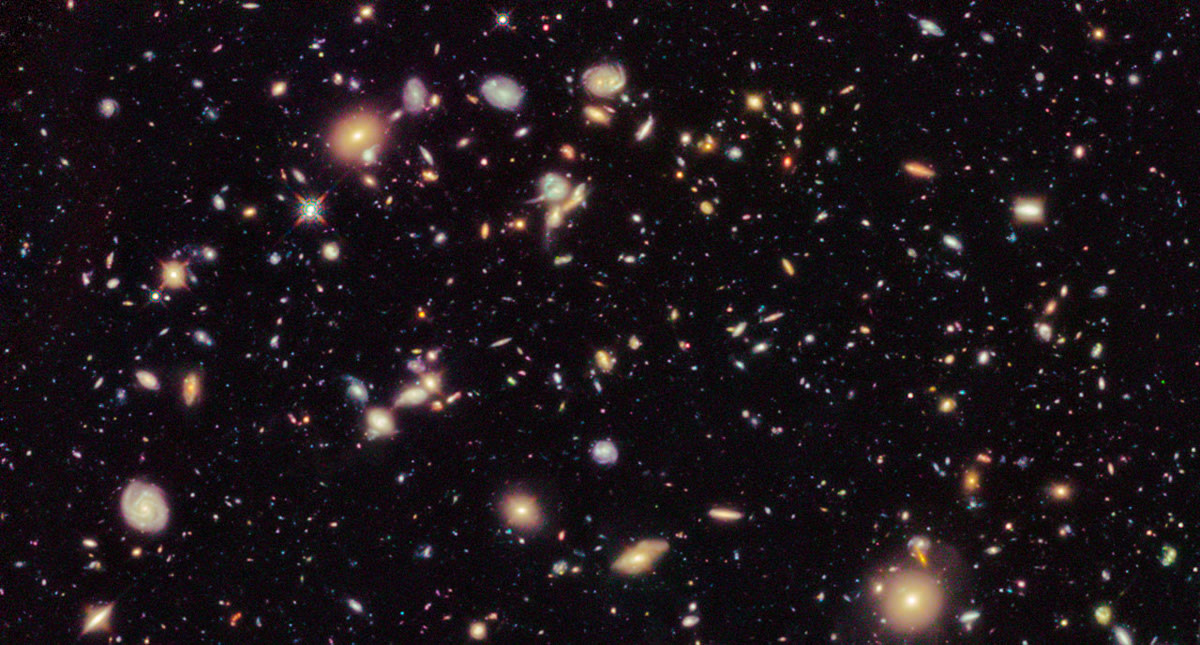
The discoverers have some theories for why they found this extremely distant star hub. The hydrogen reionization in its era may have been patchy, making it feasible to spot some galaxies but not others. Also, EGS8p7 may have been populated by exceptionally hot stars that created a giant hydrogen bubble and broadcast the galaxy's presence. Whatever factors led to this rare sighting, it's clear that humanity's understanding of the oldest galaxies still needs some fine-tuning.
[Image credits: NASA/ESA/R. Ellis (Caltech)/HUDF 2012 Team, Flickr (top); I. Labbé (Leiden University)/NASA/ESA/JPL-Caltech (bottom)]
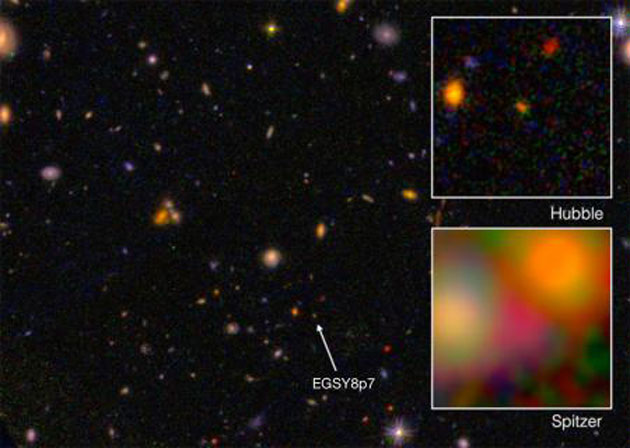

Odd X-ray pulses are streaming from the core of the Andromeda and Perseus galaxies. And the signals’ spectrum (or light signature) does not match any known particle or atom. So astronomers are tentatively salivating over the prospect of a scientific breakthrough, as this phenomenon could just be the first tangible sign of dark matter.
Dark matter—the elusive, invisible bulk that accounts for most of the mass in the universe—might be composed of sterile neutrinos, which may or may not exist depending on whom you ask. These theorized particles supposedly produce X-rays in their death throes, and such emissions could account for the unexplained surges from the center of the aforementioned galaxies.
Furthermore, since the radiation emanates from the cores of the galaxies, it corresponds to areas of highly concentrated dark matter clumps. So while nothing is certain yet, this could be a momentous discovery that would greatly increase our understanding of a long-standing universal mystery.

Hubble has revealed yet another incredible curiosity—an asteroid that thinks it’s a comet. While the latter bodies are easily recognized by their bright, streaming tails, asteroids do not usually have such features since they possess little ice and are made mostly of heavier elements and rock. So spotting an asteroid with not one but six tails was an incredible surprise.
Asteroid P/2013 P5 is a unique find with its six spouting jets, as all other pieces of cosmic debris are quite content with considerably fewer. It blasts material indiscriminately into space like a cosmic lawn sprinkler
It’s unclear why the object behaves and looks the way it does. One awesomely destructive possibility is that P5 is rotating so quickly that it’s inadvertently killing itself. Its tiny gravity is no match for the greater rotational forces ripping it apart. And radiation pressure from solar emissions stretches the scattering debris into dazzling, comet-like appendages.
However, astronomers do know that P5 is a leftover chunk from a previous impact. The tails most likely contain zero ice content, since frozen water is unlikely to be found in an object that’s been previously exploded to 800 degrees Celsius (1,500 °F).
8 HD 106906b, The Distant Monster
Planet HD 106906b is a head-scratcher. This super-monster is 11 times more massive than Jupiter, and its gaping orbit highlights all sorts of flaws in our tenuous understanding of planetary formation. HD’s distance from its parent star is an absolutely mind-boggling 650 astronomical units (AU).
The incredibly lonely Neptune, our most distant planet, lumbers around the Sun at a distance of 30 AU. This is already an amazing range, but HD is so far separated from its parent that Neptune and the Sun are comparatively within hugging distance. This huge discrepancy is responsible for the addition of many asterisks above our planetary formation theories, as astronomers scramble to explain HD’s existence in spite of its vast orbit and heft.
For example, the forces responsible for making planets are usually undone by such great distances, raising the possibility that HD was created via the collapse of a debris ring. Yet HD is too massive for that to happen. And the primordial disks of raw matter that can birth planets simply do not contain enough stuff to produce giants like HD.
Another possibility is that we’ve discovered a failed binary star system, wherein HD failed to attract enough material to ignite fusion within its gassy bosom. However, the mass ratio between potential binaries is usually no more than 10:1. In HD’s case, however, we’re looking at a 100:1 disparity.
9 Uranus Is Stormy
Photo credit: Imke de Pater/UC Berkeley
Astronomers have been caught completely off guard by Uranus. The second-farthest member of our solar family is typically frigidly calm, but for some odd reason, the planet is currently awash in raging storms.
Dazzling Uranian tempests were expected back in 2007, during its equinox as the planet completed half of its 82-year orbit, and the full solar fury was unleashed directly upon the equator. Yet the stormy weather was supposed to abate as Uranus continued its journey around the Sun. It hasn’t.
With no internal heat source, the green giant relies on solar exposure to fuel its storms. But astronomers from the University of Berkeley, California recently observed major activity in the planet’s upper region, a vast layer of frozen methane. Some of these storms are close to the size of Earth, spiraling through the planet’s atmosphere for thousands of miles and shining so intensely that even amateur astronomers can spot large patches of light across the surface.
It’s unclear how the storms managed to stay healthy without the Sun’s assistance. The northern hemisphere has plunged into shadow yet still continues to host violent storm fronts. However, it’s possible that vortexes deeper within the planet are caused by similar processes to those observed on the much more tumultuous Jupiter.
10 KIC 2856960, The Triple-Star System
Photo credit: M. Kornmesse/ESO
The Kepler Space Observatory is usually busy hunting down new planets, but it spent four years of its life tracking three gravitationally bound stars collectively known as KIC 2856960. KIC was just a run-of-the-mill triplet, two little dwarf stars orbited by a third stellar body going stag. Nothing weird so far, just three stars.
For example, Kepler saw four daily dips in the light curve as the binary dwarfs crossed each other every six hours. It also saw another slight decline in the observed light every 204 days caused by the eclipsing third star.
You’d think four years’ worth of observation would be enough to get well acquainted with KIC. And so did astronomers. But after fiddling with the numbers, the data didn’t make sense in the context of the observed behaviors of the stars. Their first job was to pin down the stellar masses. But no matter how they crunched the numbers, they failed to produce any sensible answers, even though ascertaining the mass of the stars should have been relatively straightforward.
For now, the stellar threesome has astronomers stumped. There is a potential answer that makes sense numerically yet not logically. It’s so farfetched to be almost unthinkable. The KIC system might contain a hidden fourth star. However, its orbit would have to perfectly mimic the orbit of the third star, giving the illusion of a single object.
Source:
http://listverse.com/2015/01/05/10-recent-space-discoveries-no-one-can-explain/
 Photo credit: Mark A. Wieczorek
Photo credit: Mark A. Wieczorek
Some Moon rocks brought by Apollo's teams were magnetic in nature, that means that the moon had it's own magnetic field (once upon a time) not like now, deprived of magnetic field.
A Magnetic field is generated by the what’s called a dynamo, which is caused by the fluid motion of a conducting material, such as liquid iron. In the case of the Earth’s magnetic field, this motion occurs in the planet’s outer core, and is caused by the convection of heat.
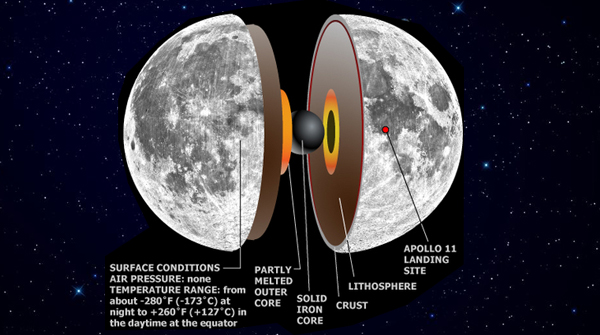
But the moon isn’t large enough for convection to take place.
the moon’s solid-rock middle layer, called its mantle, stirs up its liquid iron core. The researchers think this happens because the moon’s core and its mantle rotate around slightly different axes, and the boundary between them is not quite spherical, so their relative motion causes the fluid to mix around.
The strength of this stirring is determined by the angle between the core and the mantle, and the distance between the Earth and the moon, because the tidal gravitational tug from the Earth causes the moon’s mantle to rotate differently than the coreThis model would explain why the moon used to have a magnetic field, but no longer does. That’s because the angle between the mantle and the core has narrowed over time, while the distance between the moon and the Earth has widened, causing the tidal forces to steadily decrease. While these forces used to be enough to generate a dynamo inside the moon, they aren’t anymore.
Based on their calculations, the researchers estimate the lunar magnetic field might have lasted for about a billion years, somewhere between around 2.7 billion and 4.2 billion years ago.
“The further out the moon moves, the slower the stirring, and at a certain point the lunar dynamo shuts off,”
Source: https://sservi.nasa.gov/articles/mystery-moons-lost-magnetism-explained/
2 Galaxies 13 Billion Years Old

The early universe was an approximation of hell—a roiling, opaquely dense stew of electrons and protons. Almost half a billion years passed before the baby universe cooled down enough to allow the formation of neutrons. Shortly thereafter, the universal landscape settled further so that stars and galaxies could come into being.
A recent ultra-deep survey by the Subaru telescope—located in Hawaii and run by the National Astronomical Observatory of Japan—revealed seven of the earliest galaxies ever. Over 13 billion light-years distant, they appeared as unimaginably faint pinpricks of light. In fact, they were visible only after Subaru focused on a tiny patch of sky for over 100 hours of exposure.
Born only 700 million years after the big bang exploded everything into existence, these galaxies are among the earliest things ever observed and are among the first evidence of organization within the universe. These types of galaxies are characterized by intense hydrogen excitation and an absence of heavier elements since metals (other than minute amounts of lithium) hadn’t been blasted into existence yet by supernovae.
Termed Lyman-alpha emitters (LAE), these galaxies appeared suddenly and for (more or less) unknown reasons. LAE galaxies are prolific star-producers, and their extreme age offers insight into the evolution of the universe. However, astronomers aren’t sure if the ones captured by Subaru were newly formed or if they’d been present and were only made visible by a thinning of the cosmic gas that initially obscured them.
http://listverse.com/2015/01/05/10-recent-space-discoveries-no-one-can-explain/

Saturn’s largest moon, Titan, might be the most intriguing member of the solar system. It’s a primeval Earth, complete with an atmosphere, liquid bodies, and even suggestions of geological activity.
In 2013, the orbiting Cassini spacecraft spotted a brand new chunk of land that mysteriously appeared out of Titan’s second-largest sea, Ligeria Mare. Shortly thereafter, the “Magic Island” disappeared just as mysteriously into the translucent, –200 degree Celsius (–290 °F) methane-ethane sea. And then it reappeared again as a much larger landmass during one of Cassini’s recent radar sweeps of Titan.
The transient land confirms the supposition that Titan’s alien oceans and seas are dynamic components of an active environment, rather than static features. However, astronomers are at a loss to explain the physical processes responsible for the ephemeral landmass. Especially since it appears to have doubled in size—from 50 to 100 kilometers (30 to 60 mi) across—since it reappeared.
4 The Asteroid With Rings
All our gas giants are encircled by rings, though most of these are tenuous wisps of debris quite unlike Saturn’s massive sets of bling. And now, for the first time and quite unexpectedly, astronomers have found rings around a much smaller body. Meet Chariklo, an asteroid measuring only 250 kilometers (155 mi) across yet boasting its own ring system.
Chariklo, though the largest object in its cosmic vicinity, looked like an unremarkable chunk of space rock. Then astronomers noticed its anomalous light signature. As it eclipsed a faraway star, it caused an unanticipated dip in the amount of light reaching our telescopes. The dimming action occurred immediately before and after it crossed the star’s path, causing momentary confusion.
It turns out that Chariklo sports not one but two cosmic necklaces. Containing a good amount of frozen water, the larger of the rings hugging the planet is 7 kilometers (4 mi) wide, while the smaller is about half that size.
And while some asteroids do have “moons”—tiny satellites dancing around them—Chariklo is unique because a ring around an asteroid had never been observed. The rings’ origin is unclear, though it appears they were formed by an impact. They are either the remnants of a foreign body that shattered itself against Chariklo or pieces of Chariklo itself that blew off during the crash.
5 UV Underproduction
We pride ourselves on ascertaining the many universal balances that seem to occur throughout the cosmos. One such correlation has been observed between ultraviolet light and hydrogen, as the two have been found to coexist in well-defined proportions.
A recent survey, however, has thrown a monkey wrench into these suppositions and reported a severe underproduction of UV photons from known sources—a 400-percent discrepancy compared to predicted values. Lead author Juna Kollmeier likens it to walking into a dazzlingly bright room only to find several dim bulbs responsible for the disproportionate brilliance.
Two accepted processes produce UV radiation—unruly young stars and massive black holes—but more UV radiation exists than could have been produced by the two. Astronomers can’t explain the superfluous UV production and are forced to admit that “at least one thing we thought we knew about the present-day universe isn’t true.” That’s quite disheartening, considering that UV-hydrogen balance was believed to be very well understood. As in many times in the past, astronomers are forced back to the drawing board.
Quite mysteriously, this UV underproduction is only apparent at local distances. When looking farther off into space and time, astronomers find that their predictions hold up quite well. They’re remaining optimistic, though, since the unaccounted radiation could be the result of exotic, heretofore undiscovered processes. These possibly even involve dark matter decay.
Source:http://listverse.com/2015/01/05/10-recent-space-discoveries-no-one-can-explain/
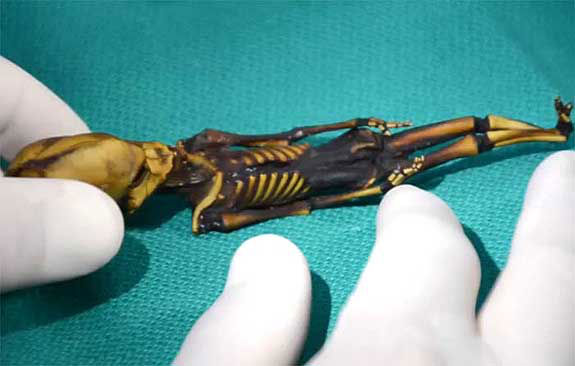 Image source
Image sourceHard teeth, bulging head, and scaled skin made most think this was something extraterrestrial. Only after it was declared human, did the question arise for an explanation for it’s size, mutations, and origin. None of those answers were ever found.
You can read more here: Skeleton Of ‘Alien Looking’ Tiny Creature with Nine Ribs Which Was Discovered Was Actually A Human, Reveal Scientists
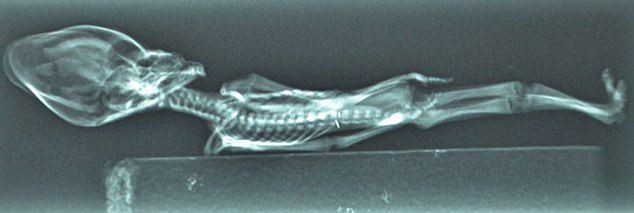
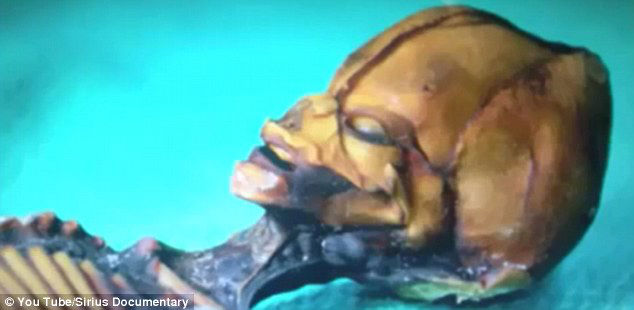
 Image source
Image sourceLady Dais of the Han Dynasty, is China’s eternal mummy. Her skin was still soft, and her arms and legs could flex at the joints, and remains to this day, the most well-preserved ancient human ever discovered.
Source:http://www.ancient-origins.net/ancient-places-asia/enduring-mystery-lady-dai-mummy-001357
3. Two men arrived at a sheriffs office claimed to be abducted by aliens with lobster-claw hands (1973). image source: www.twincities.com
image source: www.twincities.comCharles Hickson and Calvin Parker were fishing when they said they were taken. They talked in distressed voices about the abduction, told the same story (even though they were in different rooms), and Hickson even passed a polygraph exam.
Source: https://en.wikipedia.org/wiki/Pascagoula_Abduction
4. “The Black Knight Satellite” whose origin and purpose were unknown, was spotted before any man-made satellites were invented.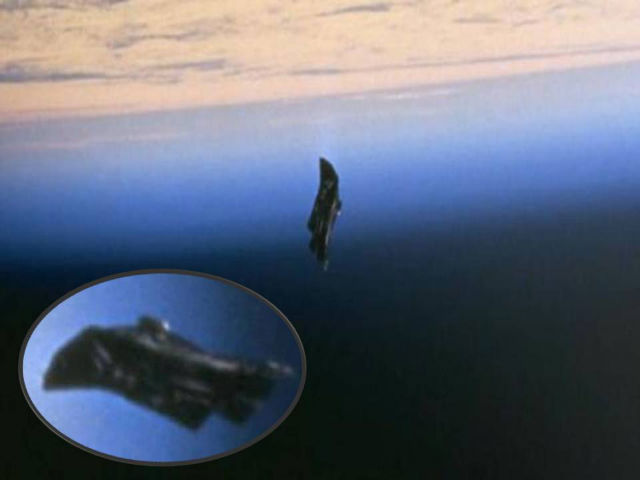 Image source: www.abovetopsecret.com
Image source: www.abovetopsecret.comIn 1954, a retired air force major reported that the U.S Air Force spotted two satellites orbiting Earth. Some claim this black knight satellite may 13,000 years old, and has been both sighted and photographed.
Source: https://en.wikipedia.org/wiki/Black_Knight_satellite
5. A Boeing 727 was stolen in 2003 from an Angolan airport even though the suspected thieves were believed to have no abilities to fly an aircraft. Image source: www.airspacemag.com
Image source: www.airspacemag.comThe plane took off without any communication or clearance from the tower. With the lights off, and transponder disabled, it flew above the Atlantic Ocean never to be seen of again.
Source: http://www.theweek.co.uk/mh370/57683/the-mystery-of-mh370-egyptair-flight-ms804-and-seven-other-planes-that-vanished
6. The Kepler telescope has spotted roughly 1,200 possible worlds, including 68 that are earth sized planets. Image source: deviantart.net
Image source: deviantart.net1 out of every 37 to 1 out of every 70 sun-like stars may harbor an alien earth. These findings alone can hint to billions of planets in our galaxy that could harbor life.
Source: http://www.space.com/11188-alien-earths-planets-sun-stars.html
7. There is a 240 paged book called The Voynich Manuscript, it was said to be written in the early 15th century in a language completely unknown. Image source: Beinecke Rare Book & Manuscript Library, Yale University
Image source: Beinecke Rare Book & Manuscript Library, Yale UniversityThe illustrations point to the possibility that the book is a medieval or early modern book of medicine. The Voynich manuscript has been studied by many professional cryptographers, yet no one has succeeded in deciphering the text.
Source: https://en.wikipedia.org/wiki/Voynich_manuscript
8. A man spent 67 years of his life stereoblind, which is the inability to experience depth perception. Only after having to pay for 3D glasses to watch the movie Hugo, that his brain suddenly clicked. Image source: www.bbc.com
Image source: www.bbc.comAbout 5-10% of the population who have stereoblindness see the world as if it was a background image. He was able to experience three dimensional vision long after the movie ended even though conventional wisdom stated that it is impossible.
Source: http://www.bbc.com/future/story/20120719-awoken-from-a-2d-world
9. In 1975 odd and anxious behaviors of dogs and other animals led to the evacuation of a city who, hours later, experienced a 7.3 magnitude earthquake. Image source: www.earthmagazine.org
Image source: www.earthmagazine.orgIn the Chinese city of Haicheng, these observations led to an order for 90,000 residents to evacuate the city. Only a few hours afterward, a 7.3 magnitude earthquake destroyed nearly 90% of the city.
Source: https://www.psychologytoday.com/blog/canine-corner/201205/can-dogs-predict-earthquakes
10. The world’s largest virus, named Pandora, was found off the coast of Australia, it also holds about 93% of unidentified genetics. Image source: www.labrujulaverde.com
Image source: www.labrujulaverde.comThis suggests an “extraterrestrial” origin, and they cannot say without absolute certainty that it does not pose a danger to human kind.
Source: http://www.spacedaily.com/reports/Pandora_virus_covert_threat_from_space_999.html
Source:
http://www.unbelievable-facts.com/2015/04/mysterious-facts.html/3

